With a classic silhouette and decades of heritage behind it, the trench coat is an absolute must-have for your wardrobe. Famous for its double-breasted style, learn all about the history, and characteristics of a classic trench coat in this guide.
- Watch More in our Trench Coat Video Guide
- What Makes it a Trench Coat?
- Trench Coat Characteristics
- The History of the Trench Coat
- Born for the Battlefield
- How Should a Trench Coat Fit?
- Where to Buy a Trench Coat?
- How To Buy A Used Burberry Trench Coat
- Authentic or Fake Burberry Trench Coat?
- Genuine Burberry Details
Watch More in our Trench Coat Video Guide
Raphael is happy to brave the rain in order to bring you all the information about men’s trench coats. Sit back and relax as he guides you through the trench coat’s past, as well as its defining features. You’ll be picking out the best men’s trench coats in no time!
What Makes it a Trench Coat?
There are many different options out there that profess to be authentic trench coats, but the reality is many of them are not. Whether it’s the knee-length minimum or the belted waist, the DNA of a genuine trench coat is made from a very particular set of features.
Trench Coat Characteristics
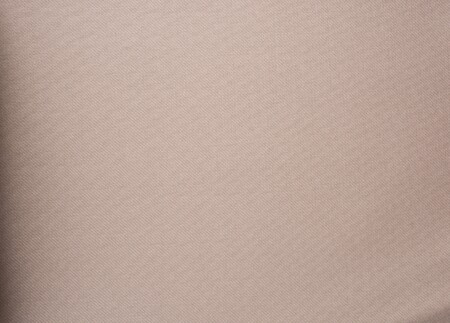
Trench Coat Fabrics
Although originally rubberized, traditionalists will argue there is just one choice of trench coat fabric: 100% cotton gabardine as invented by Thomas Burberry. Tightly woven of a worsted cotton, it is both lightweight and durable. Both the yarn and finished cloth are waterproofed, achieving remarkable water repellent properties.
There was a time when leather was frequently used for trenches. However, due to negative associations from the Second World War and being used as costumes for villainous characters, a leather trench coat is best avoided. Choose a bomber jacket instead.
Fabrics like Gore-Tex or Event Fabric could also be used, but these simply aren’t as elegant on such a traditional garment.
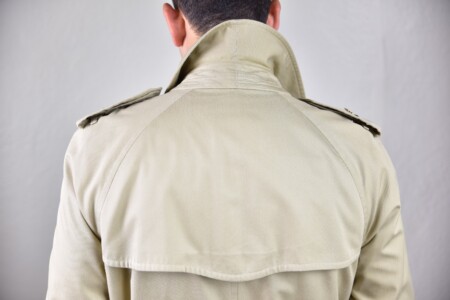
Raglan Sleeves
The raglan sleeve made its debut in the 19th century, and just like the Chesterfield coat, it owes it name to an aristocrat: FitzRoy Somerset 1st Baron Raglan. The purpose of the diagonal sleeve heads is to aid mobility and ease of putting the coat over bulky layers. While traditionalists would choose the raglan sleeve, it is also possible to find trench coats that have either traditional suit-like sleeve heads, or a combination of both.
At the base of the sleeve, you should also find sleeve straps at the cuffs. These can be tightened to keep out the elements.
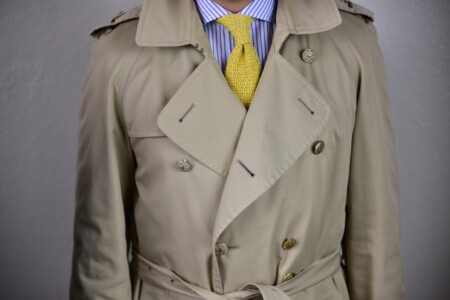
Double Breasted Closure
From its military origin, a trench coat is traditionally double breasted and features ten buttons on the front. Of course, there are all kinds of double breasted and single breasted versions available with multiple button & belt configurations, but the first coat has always been the 6×2 DB cut.
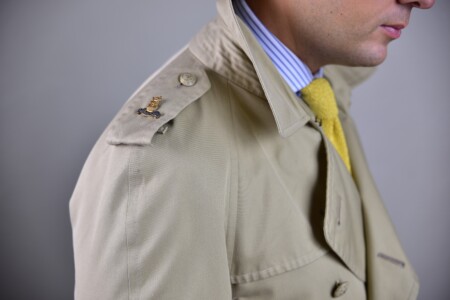
Epaulettes
The infamous shoulder tabs often seen on military uniforms also found their way on a trench coat, but they were not added merely to indicate rank. Much rather, they were used to secure gas masks, gloves, or whistles.
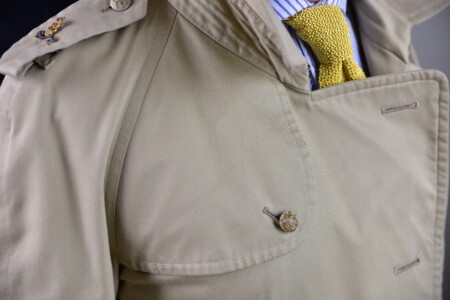
A Gun Patch or Storm Flap
The gun patch fulfilled two functions. It could serve as a gun flap for the recoil of a rifle, but more importantly, it prevented rain water flowing down the shoulders from entering the inside of the gun. This feature is somewhat mirrored with a deep back yoke that allows water to cascade away from your back, keeping you drier. This feature is not seen on many other garments and as such, it is unique to the trench.
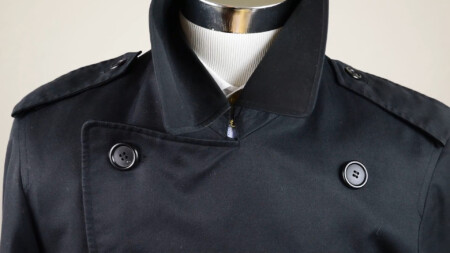
Throat Closure
Just below the large collar, you will find a hook and eye that allows you to easily keep your collar closed up all the way. It is often secured with a strap and buckle system that is hidden underneath the collar, a feature also known as a throat latch.
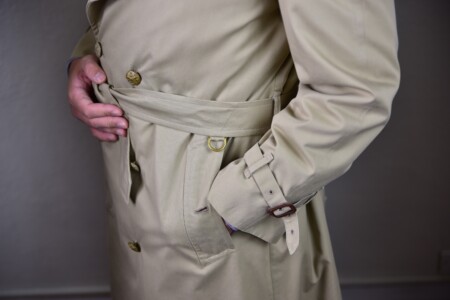
D-Ring Belt
Initially, the belt with its D-rings was used to suspend items of equipment, such as grenades or even a sword. Although the sword is no longer used with a trench coat, the belt enables you to create an attractive silhouette by sinching and defining the waistline. the D-rings remain as a memory of the original military feature.
Leather buckles should be found on all of the trench coat’s belts. Technically, metal buckles would perform just as well, but the leather helps prevent premature wear to the fabric of the trench coat.
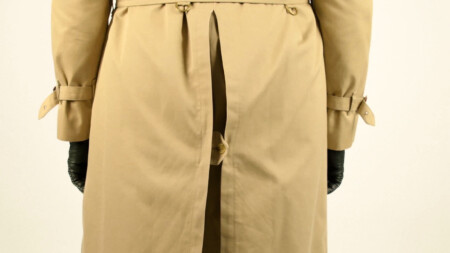
Pleated "Wedge" Back
For you to be able to move freely, your trench coat needs a vent. To keep you dry and warm, it was tailored with a wedge, which is a form of box pleat. Wedged vents are great because they continue to block the wind and rain while allowing added movement, and a trench coat’s vent typically features a button closure to further protect you from the elements.
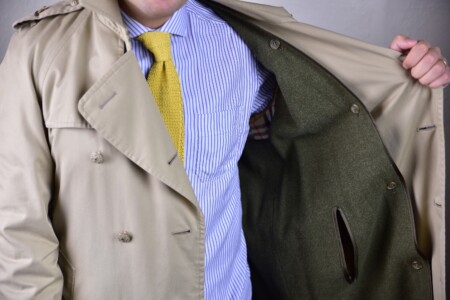
Storm Pockets
The angled storm pockets can be buttoned up from the outside to keep out the rain. All proper trench coats have through pockets than can be reached from the inside and outside. This is a great feature when traveling because you can wear the coat buttoned or unbuttoned, and always have access to your wallet or passport.
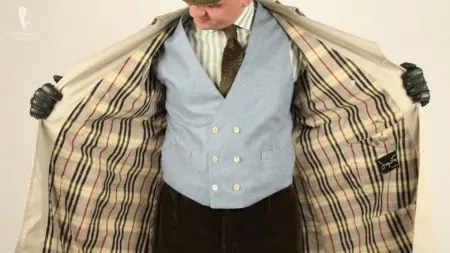
Checked Lining
Traditionally, trench coats feature a classic checked lining. For the cooler days, you can also find trench coats with a removable wool lining that can be attached with buttons, making it a particularly versatile piece of outerwear. Often, you’ll find these liners have a mixture of fibres such as 95% wool with 5% camel hair, or even a cashmere blend.
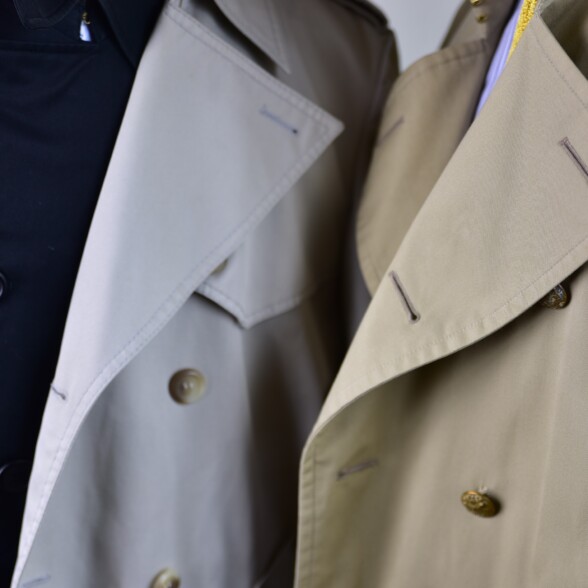
Classic Colors
The most traditional trench coat color is camel or khaki. Other popular colors include sand, stone as well as navy blue or black. Today, you can find them in practically any other color under the sun. Do bear in mind the lighter the color the more quickly it is stained. For that reason, Raphael often travels with a darker trench coat to mitigate the risks of any potential stains throughout his trips.
Trench Coat FAQs
What is a classic trench coat?
A classic trench coat should be a double-breasted overcoat made with waterproofed cotton Gabardine. It should reach the knees and have several defining features such as a gun flap and belt with D-Rings.
Which trench coat should men buy?
There are many options for men’s trench coats, with a lot of collectors prizing the pre-1999 Burberrys’ models. While these can be challenging to find, there are many excellent options from several different quality brands on the vintage market including Macintosh and Aquascutum.
Are trench coats for men still in style?
Trench coats are a fantastic piece of outerwear that classic style enthusiasts adore. They are very versatile overcoats, and purchasing one with a removable wool blend liner helps increase its usefulness.
Should men wear trench coats?
If you’re interested in classic style, then a trench coat is likely on your wish list if you haven’t already got one! A trench coat could arguably be seen as an all-season piece, as it can be configured to suit many different situations including rain, wind, and snow.
What do you wear under a man’s trench coat?
Traditionally, trench coats were intended for the military, who wore bulky uniforms underneath them. Nowadays, trench coats can be worn with almost anything underneath including suits, sweaters, and even casual trousers such as denim jeans.
Should a trench coat be fitted or loose?
With their original function as military garments, trench coats are designed to have a looser fit for added mobility. Classic trench coats should still fit you well, unlike the oversized trends seen in the 1980s, but shouldn’t be so tight that you can’t fit it over a jacket, like the skinny fit trends of the 2000s.
What is the point of a trench coat?
Trench coats were originally designed as a way of protecting soldiers from the harsh conditions in the trenches, hence their name. Following their use in the war, trench coats became extremely popular as everyday protection from adverse weather including high winds and heavy rain.
Do you need a trench coat for winter?
A trench coat can be an excellent garment when it comes to transitional seasons, as well as the depths of winter. A trench coat with a removable wool liner allows you to add another layer of warmth to help keep the cold at bay.
What is the best color for a trench coat?
Traditional trench coats come in a wonderful shade of khaki, however, you are able to find trench coats in many different colors. A darker color such as grey, navy, or black can be a great option for travel.
Do trench coats go with everything?
While trench coats remain extremely versatile garments, there are a few scenarios in which they look out of place. Namely, with summer wear, and evening wear. While you may want an additional layer during the summertime, a trench coat can look a little over the top. When it comes to formality, occasions requiring a higher degree of attention (such as black or white tie dress codes) are also areas to skip the trench coat and opt for something more formal.
The History of the Trench Coat
The Trench Coat has come a long way from the battlefields of the 19th century. As far as overcoats go, the Trench Coat is about as iconic as they come, appreciated for its classic form and functionality by men of all tastes.
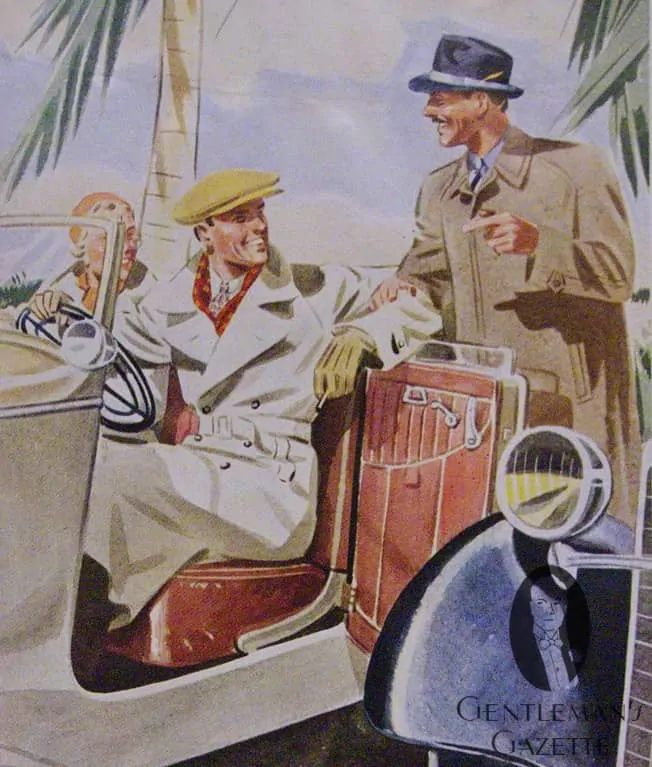
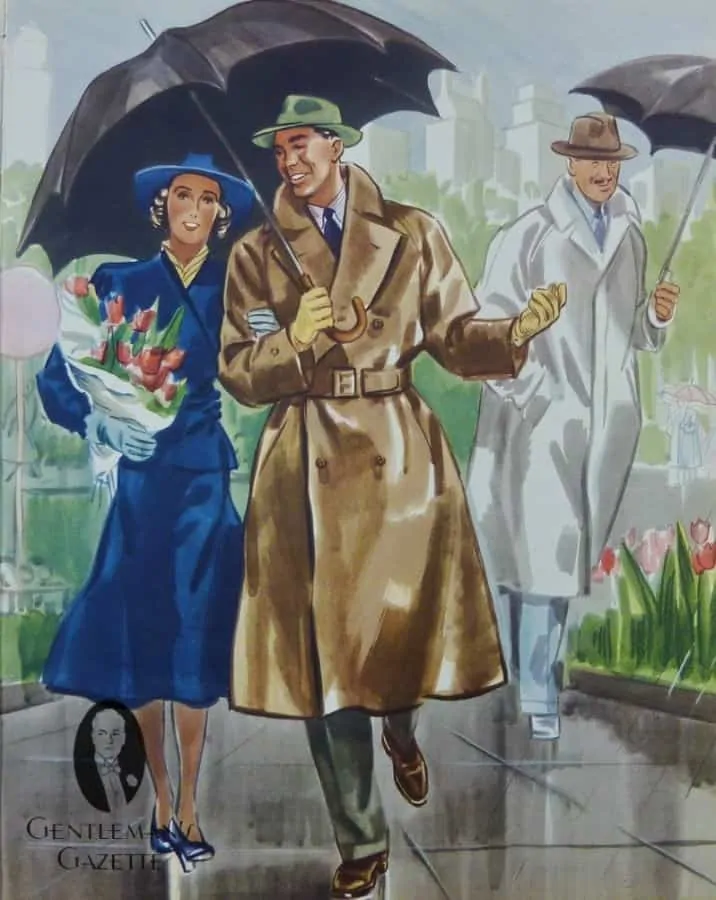
As with many garments today, there are numerous theories about the exact origins of the trench coat. While we may never know the true story, here are the most likely beginnings of the trench coat as we know it today.
Macintosh Trench Coats
It seems that the 18th-century coachman’s coat – which was also the predecessor of the greatcoat– was likely the forefather of the trench coat. Unlike modern designer garments, each characteristic feature of the trench was born out of practicality.
Today, the trench coat is classified as a raincoat, which brings us to our starting point at the beginning of the nineteenth century. Back then, gas lighting was becoming increasingly popular, and in Glasgow, Scotland, the gas was derived from coal. In 1818, the Scotsman James Syme realized that the by-product, coal-tar naphtha, was capable of dissolving rubber. As has occurred so many times in history, the inventor/discoverer passed on his information to a savvy business person – in this case, Charles Macintosh, who had successfully made a lot of money with dry bleach.
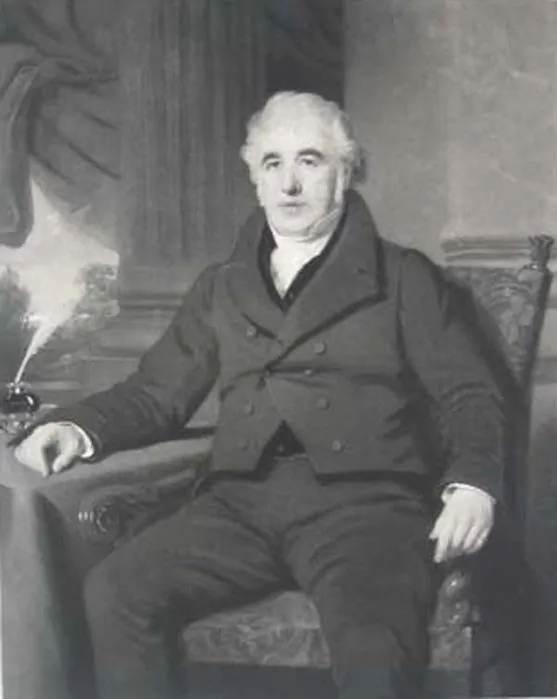
By 1823, Macintosh had found a way to make use of this adhesive rubber solution in garments. He applied it between two layers of cloth, which resulted in a waterproof raincoat that did not feel at all like rubber. Despite the fact that this raincoat had a most unpleasant odor, Charles Macintosh & Co. was founded in 1824 in Manchester, England, which was home to the cotton mills that provided the raw materials for the raincoats.
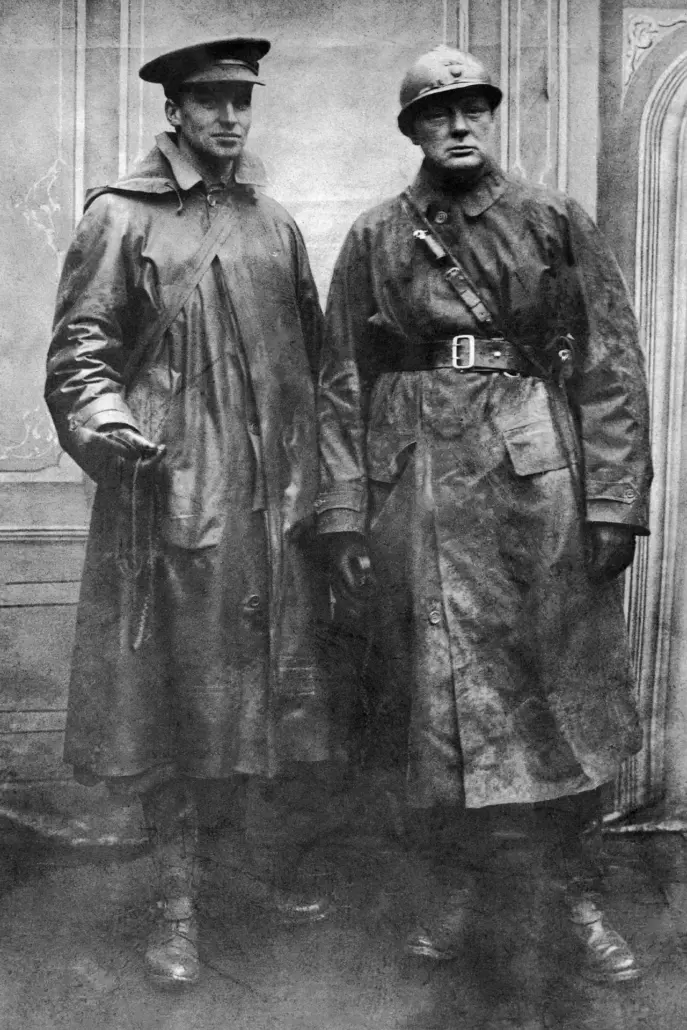
Although Macintosh was able to sell quite a few of these purely practical garments, the smell was not its only undesirable feature. With the charm of a potato sack, the coat also became sticky like honey in the heat and hard as a board in the cold. The fumes also proved to be toxic for the factory workers, leading to the coat falling out of favor by the late 1830s.
Advances in production were made, and so by 1854, the company Hellewell advertised the five ounces reversible Paletot, which looked more fashionable and hence was popular with anybody who had to face the elements. Overall, the second incarnation of the raincoat was so popular that they were referred to as “Macintoshes”, which is why you might hear people referring to them as a “rain mac”. Today, the Mackintosh coat bears the letter ‘k’ in the name Mackintosh, and the company is now Japanese-owned.
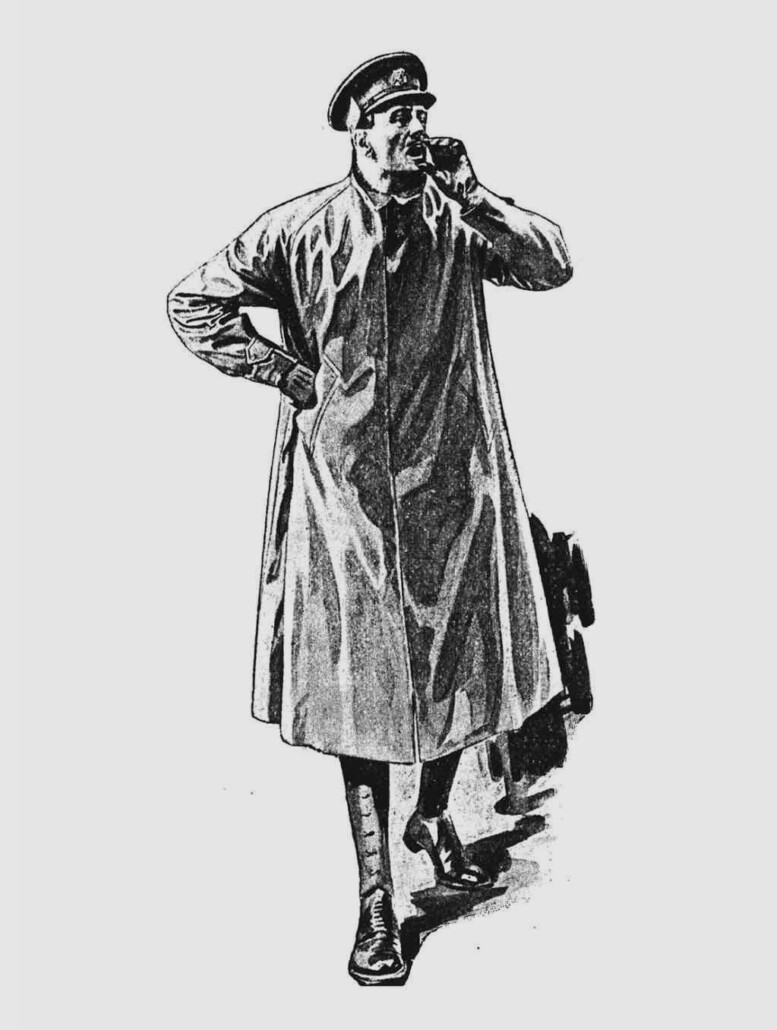
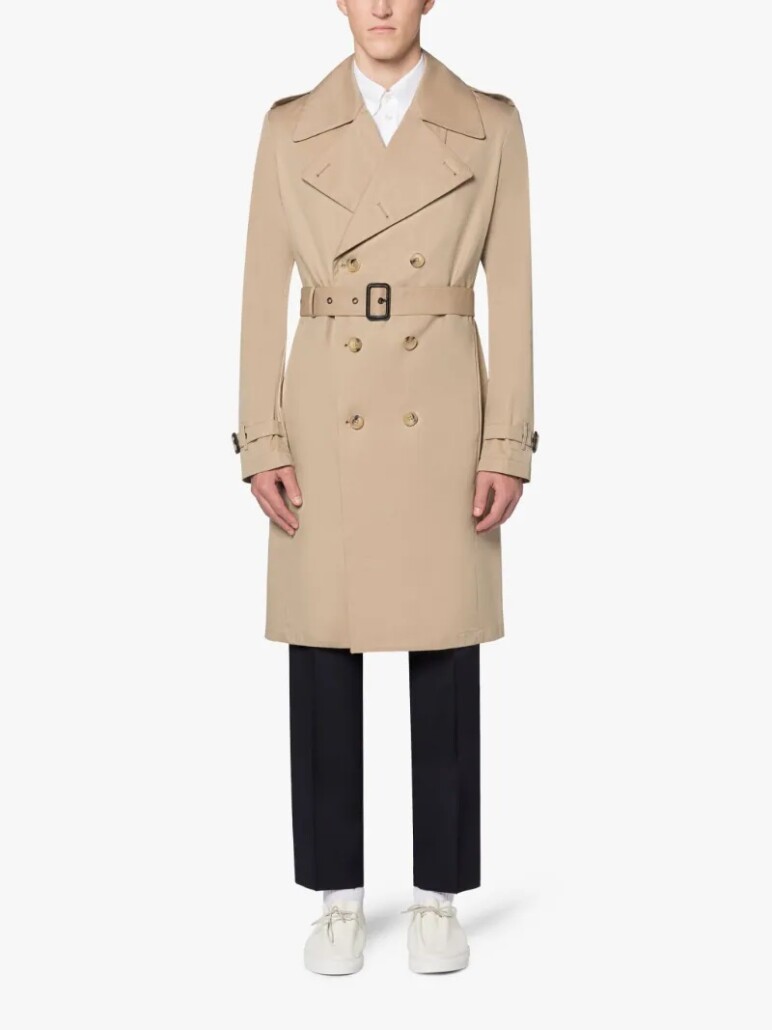
Aquascutum Trench Coats
While the Manchester rainwear production was about to reach its peak, two gentlemen from southern England were working on their own interpretation of this very raincoat. One of them was John Emary, who had opened a tailor’s shop on Regent Street in 1851.
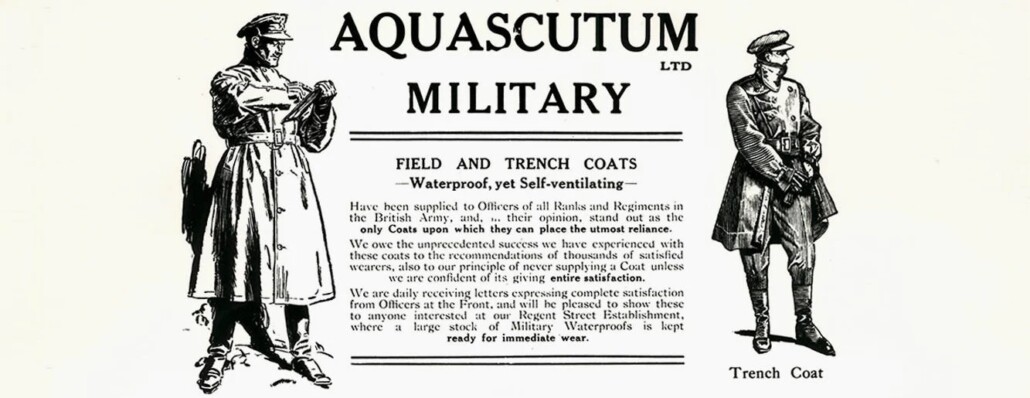
He developed a special raincoat that he called Aquascutum, derived from the Latin aqua = water & scutum = shield. Soon after that, Aquascutum was producing coats for British soldiers. These were long coats that reached the ankle and were mostly made up in a double-breasted fashion.
The raincoat was produced in larger numbers for the British military beginning in 1853 and used in the Crimean War, and it even made an appearance during the American Civil War (1861 – 1865), the Boer Wars, and the Russo-Japanese War (1904 – 1905).
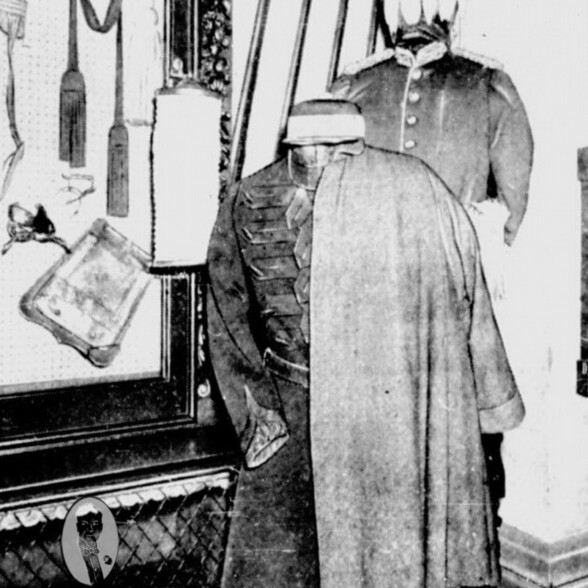
The World’s Oldest Trench Coat
The oldest likely ‘trench’ coat in existence today is the Aquascutum of Lt. General Gerald Goodlake, which is preserved at Newstead Abbey, England. He wore this coat during the Crimean War, in which he commanded a force of sharpshooters. The gray coat worn by Goodlake is displayed next to his general’s uniform. It was made of an all-wool cloth by a famous West of England mill and waterproofed to the extent possible at the time.
Burberry Trench Coats
In 1856, a 21-year-old draper’s apprentice, Thomas Burberry, opened an outerwear shop in Basingstoke, England. Since he had grown up in the countryside, he noticed that the linen garments of farm workers had certain properties that he wanted to transfer to overcoats and topcoats.
This farmer’s clothing was lightweight and not constricting, warm in the winter, breathable in the summer, and shower resistant when damp because the material shrank once it got moist. Although Aquascutum was the first to produce weatherproofed raincoats on a large scale, by the 1870’s Thomas Burberry had developed into a fierce competitor.
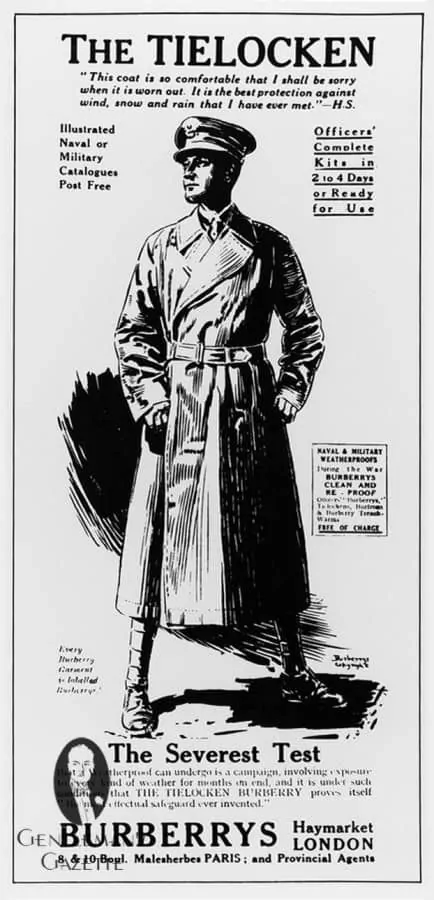
Unlike the rubberized version of Emary, Burberry followed a different approach. Instead of wool, he used sturdy fabric that was woven of a long staple Egyptian cotton yarn that was waterproofed before and after the weaving. He called it Gabardine – today also known as gaberdine – which was, in fact, an old term that had been outdated at the time.
The advantages were that it was lightweight, odor-free, hard-wearing, and waterproofed. In 1879, he registered the term Gabardine as a trademark, which would last for 40 years. World explorers like Amundsen and Shackleton would use Gabardine for their exhibitions, and it was widely used during the Boer Wars.
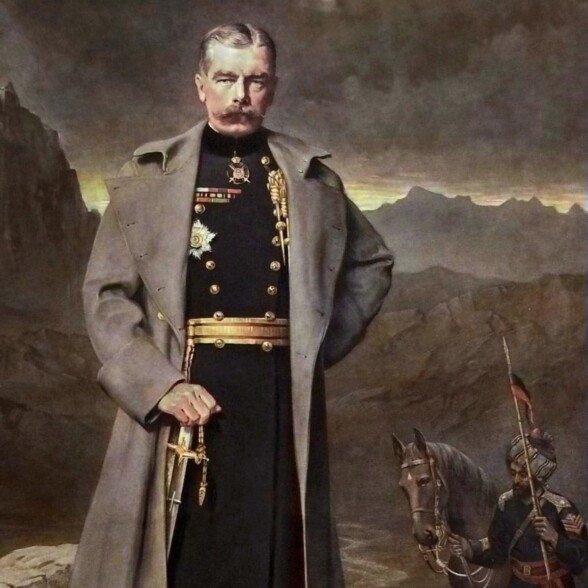
Lord Kitchener’s Trench Coat
Field Marshal Lord Kitchener, who cut an iconic British figure with a mustache and a trench coat. His preferred model was the Tielocken model, which had been patented in 1912 as a coat with a strap and a buckle instead of buttons and buttonholes. Many officers aspired to follow him, and when he died on a sinking ship during the war, he supposedly wore his trench coat, helping to cement the coat’s then-legendary status.
Born for the Battlefield
Despite, Burberry’s prominent proponents, Aquascutum also had a loyal following that would send back raving letters from the front lines, which would go on to become part of Aquascutum’s advertising campaigns. During WWI, trench coats were cut in different lengths; they were generally shorter and sometimes they would just reach above the knee in order to aid movement in the cramped and narrow trenches.
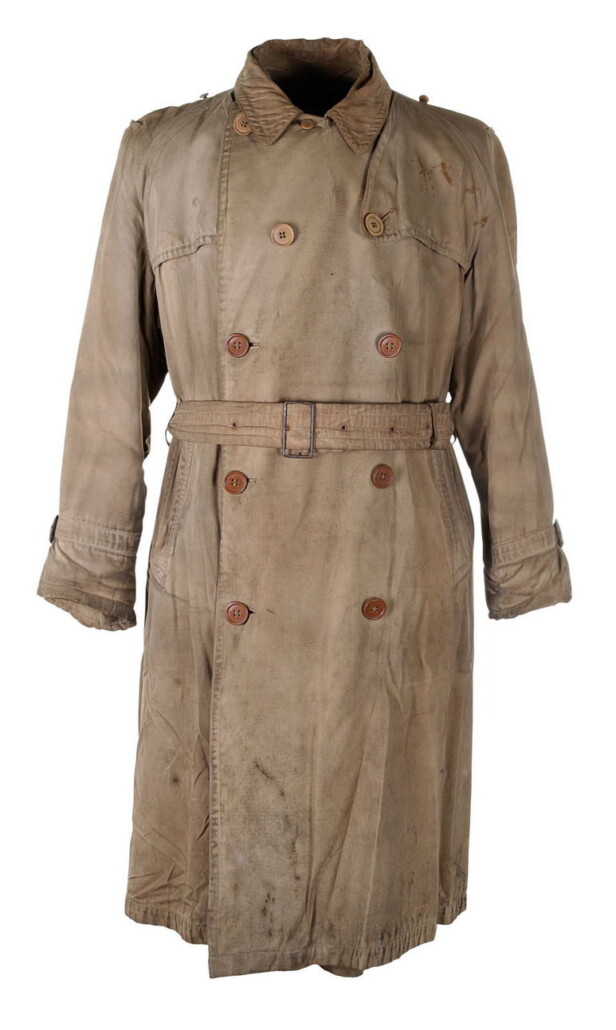
They also featured epaulets and D-rings. Almost as famous as the sand, olive, and khaki colors were blue & gray gabardine with a checked lining. While some suspect that this was a designer’s invention of the 20th century, checked-lined rainwear was, in fact, the standard in the 1880s and 1890s. There was a period in the mid-twentieth century in which trench coats were often lined in solid colors, but today the checked lining is just as distinctive as the outer shell.
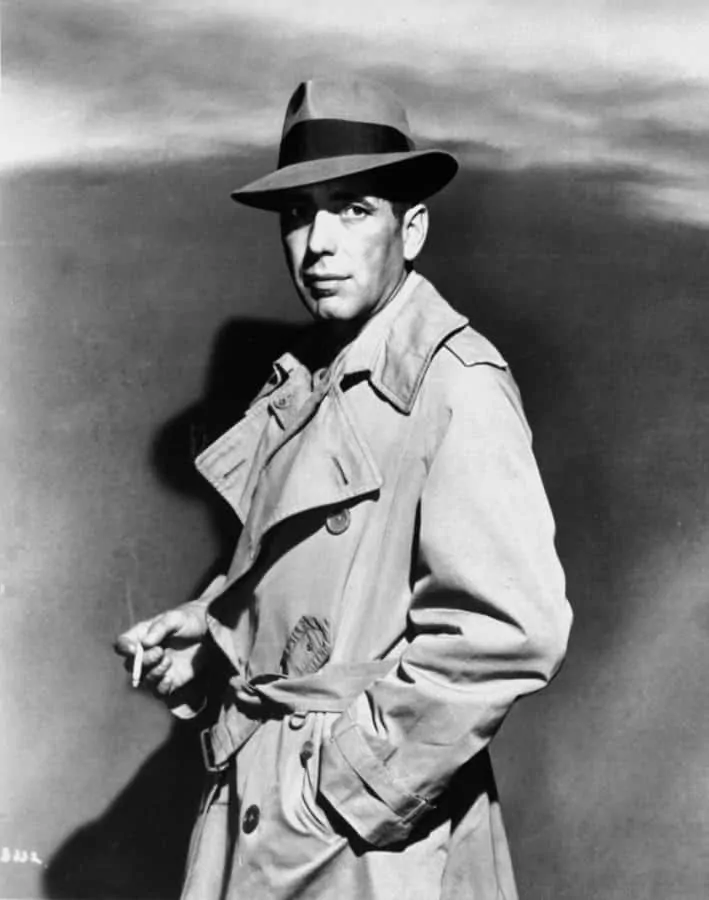
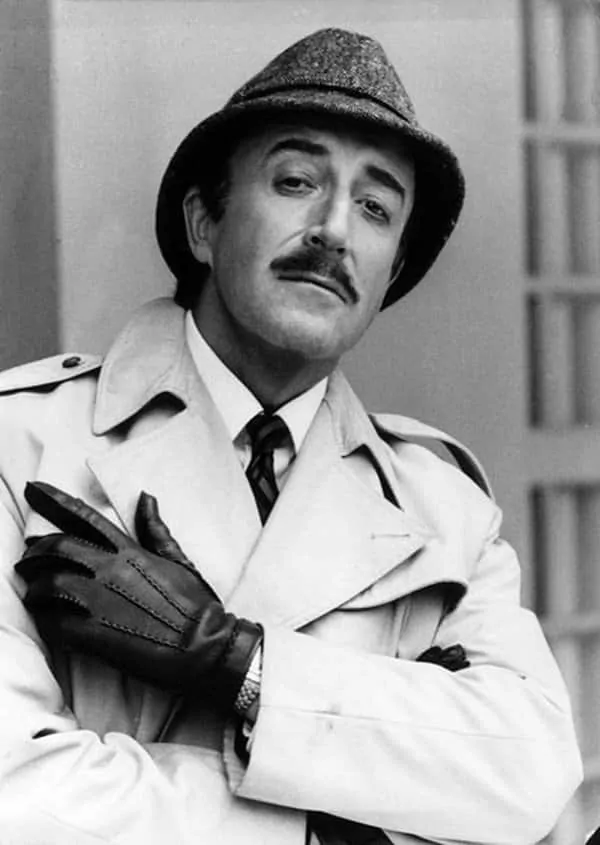
The trench coat remained very popular during the interwar years, and there are a few key reasons. Firstly, in Britain, the government had ordered thousands of trench coats and found itself with a hefty surplus at the end of the war. They were distributed to the public in the 1920s. Secondly, officers were happy to make use of their uniforms in civilian life, especially since these garments were tough, hard-wearing and fabric remained a scarce commodity. Thirdly, Hollywood stars showcased the trench coat in films across the US, many of which are cultural treasures themselves; just think of Casablanca and Humphrey Bogart, or the Maltese Falcon.
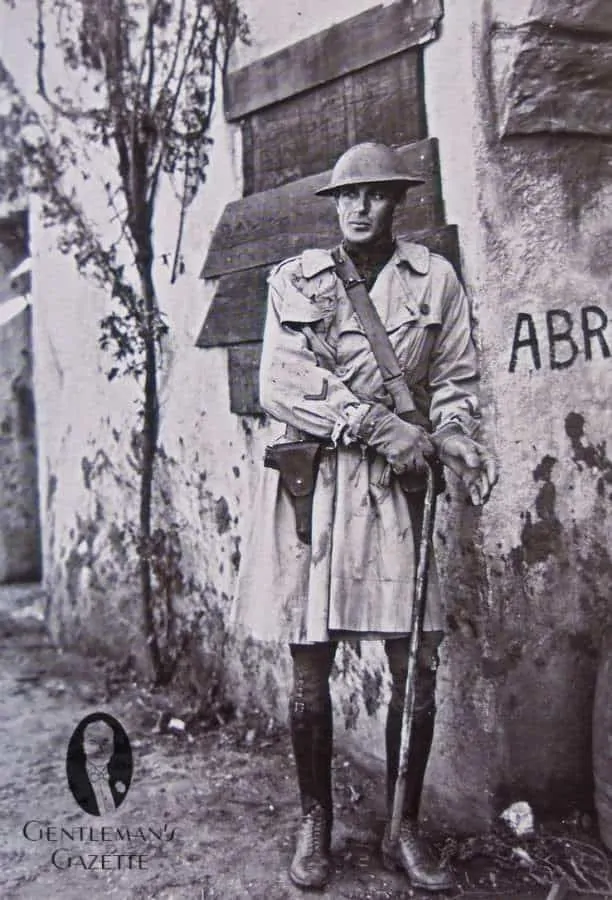
World War II Trench Coats
Since the combat strategies of WWII were different and less trench-focused than WWI, shorter multi-functional field jackets (some even camouflaged) were now the garment of choice, and the trench coat lost its military significance. Of course, you’ve probably seen photographs of German officers from the time in black leather trench coats, but these were worn to make an impression rather than for their practicality. Nevertheless, the trench coat remained popular with the public thereafter.
Aquascutum blended newly-invented nylon with cotton to create water and wind-resistant fabrics such as Aqua 5, long before Gore-Tex & Windstopper became household names. In the following decades until today, the trench coat has been popular with countless designers for men and women alike.
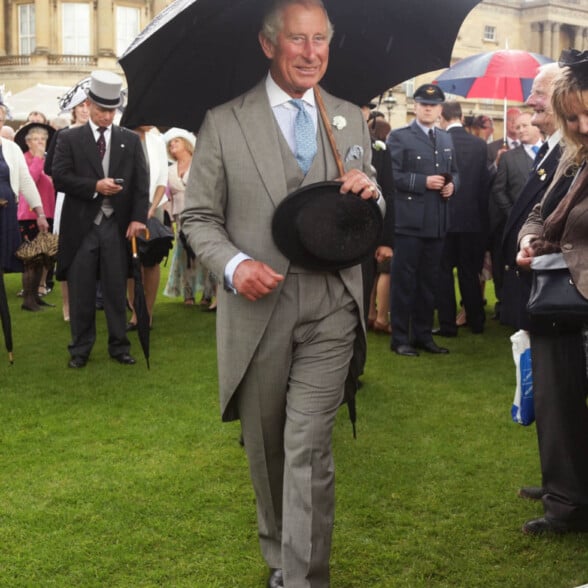
Rainy Days
With original trench coats being made in famously rainy England, you’d be forgiven for thinking this is where the best trench coats are made nowadays. But, as we’ve previously explored, quality is not limited to a particular country. For example, Burberry makes most of its coats in Turkey nowadays, and many other high-end designers such as Gucci or Prada will likely have their trench coats manufactured somewhere cost-effective. So try not to pay too much attention to where the coat was made, and look for other quality features instead.
How Should a Trench Coat Fit?
Most trenches are not worn skin-tight since they were worn over other garments, such as uniforms, suits, sweaters, and the like. Therefore, a trench coat is designed to give a little extra room, and not be tailored close to the body.
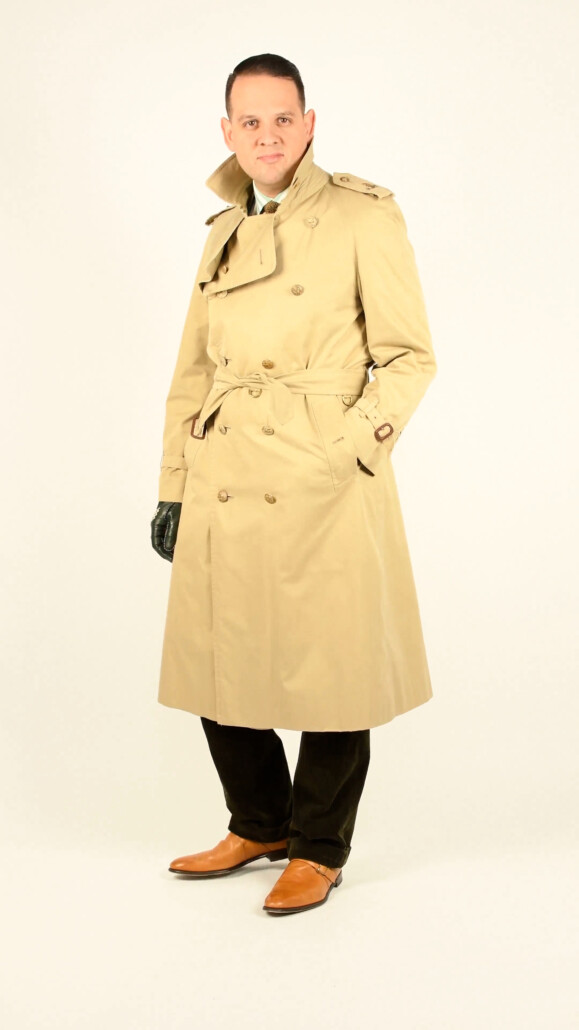
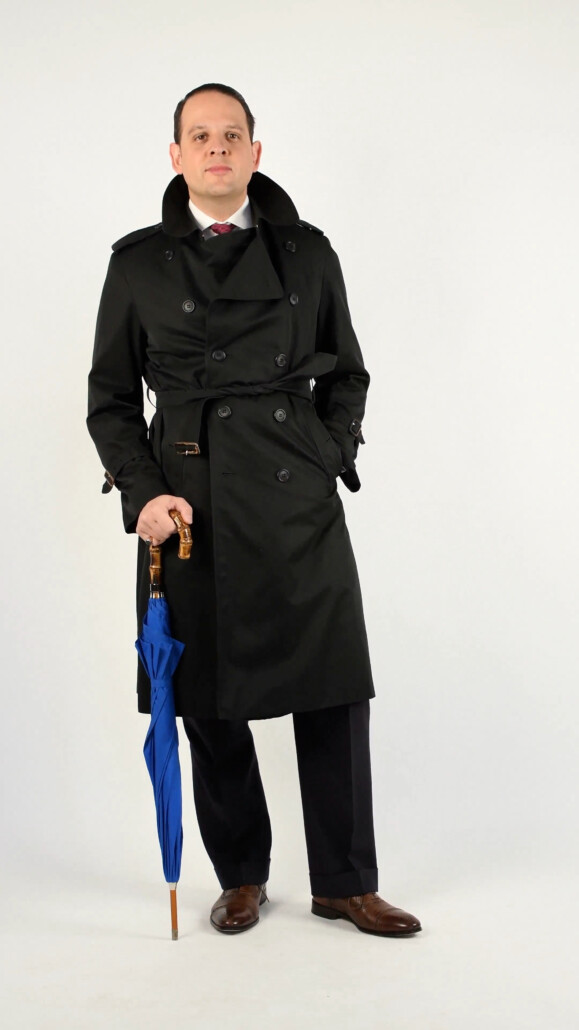
If you wish to wear a suit underneath it, bring a suit when you try coats on, and wear it both with and without your suit coat to ensure you’re getting the fit you want. Also, decide whether you want a detachable liner or not, as it is not as easy to add one in after the fact.
The sleeve should reach to the root of your thumb, so your sleeves underneath are covered completely, and your shirt cuff should remain out of view when you move around. Anything longer than that will make you look like you haven’t yet made it to the alterations tailor.
Bear in mind, there is not one traditional length for a trench coat. Advertisements and pictures from back in the day range from above the knee to the mid-calf and sometimes even to the ankle. The most versatile coats are worn at about knee length.
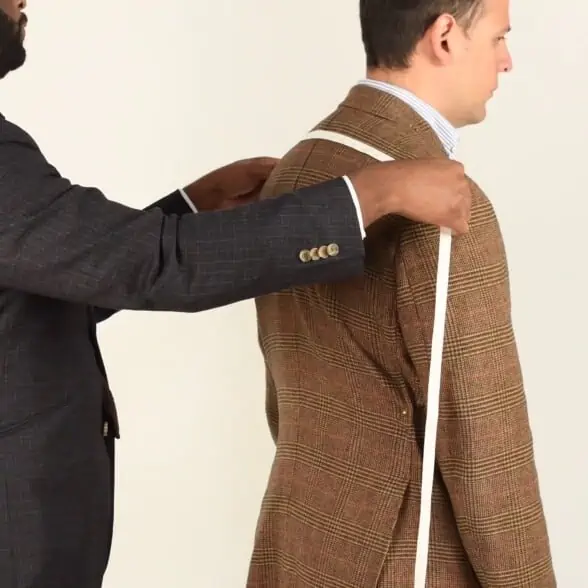
Trench Coat Alterations
As with most garments on the rack, keep in mind that you can make them smaller by one or two sizes, but rarely bigger. Never have extreme alterations done since they will distort the proportions of the belt lines, buttons, pockets, etc., and you will look unintentionally awkward, despite all your efforts.
Where to Buy a Trench Coat?
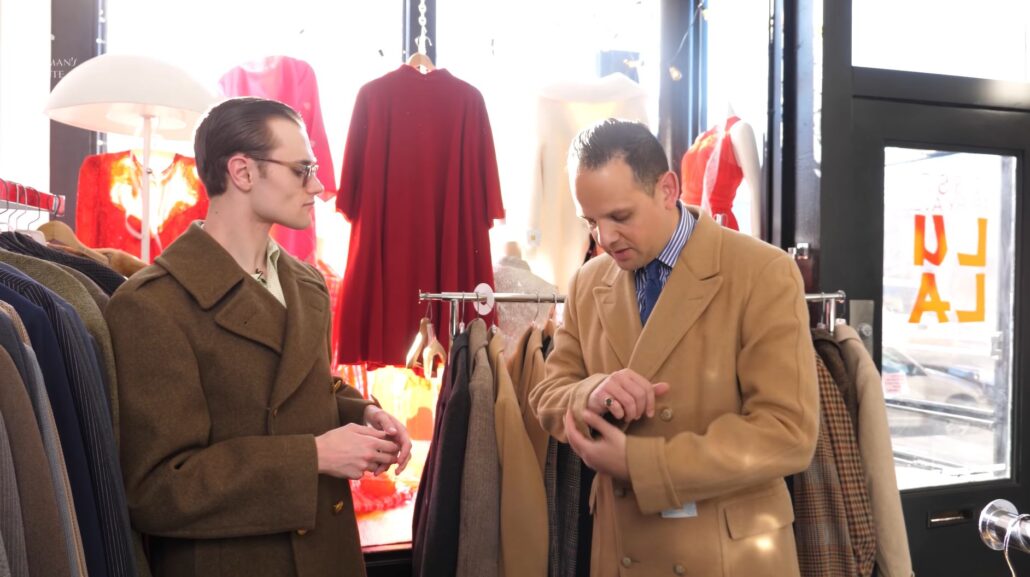
Ready To Wear Trench Coats
This is the easiest and quickest route to buy a new trench coat at a store. Burberry, Aqascutum, and Mackintosh still carry their original styles, but they will likely set you back more money than you might be prepared to part with. Many of the more modern varieties might be a good piece to invest in and treat with care as there is a good resale market for Burberry trench coats, but it’s usually best to avoid this if you’re looking for a trench coat to use practically.
Vintage Trench Coats
Old Burberrys’ or Aquascutum coats are the real deal and should last you for years, but it can be a labor of love to find one in good condition. Raphael happened to spot his first one for 125 EUR in a men’s vintage store in Germany, so it’s worth investigating what you like and keeping an eye out for it. Alternatively, you can take a look on eBay, where you can always find a plethora of different trench coats.
Bespoke Trench Coats
If your tailor can source the right kind of gaberdine and the wool liner as well as the pattern, a custom trench is certainly an option that is hardly more expensive than the established brands.
How To Buy A Used Burberry Trench Coat
Today, Burberry Trench Coats are designer investment pieces rather than practical garments. Therefore, you might want to try finding a vintage quality Burberry because these were the durable classics that contained all the defining details.
Not All Burberry Trenches Are Alike
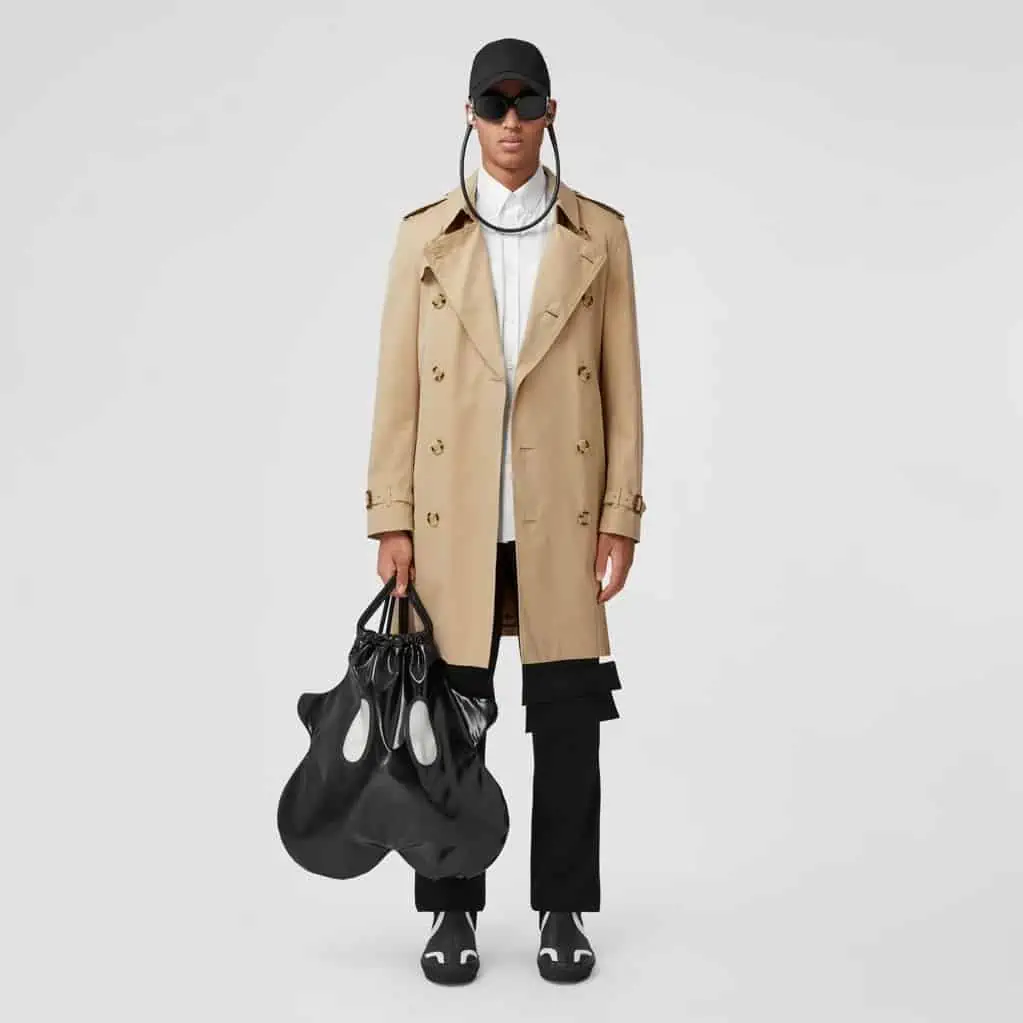
It’s important to know that Burberrys’ changed to BURBERRY in 1999. Most collectors prefer the pre-1999 trench coats to post-1999 versions because they were almost completely made in England, with a higher focus on quality. Today, BURBERRY is more of a fashion brand than a provider of top-quality garments.
Burberrys’ vs. BURBERRY
Fortunately, it’s very easy to distinguish the coats when shopping for a vintage Burberry. The pre-1999 trench coats have a label that reads Burberrys’ with an s and apostrophe (‘) at the end. The font is usually white on a navy or dark blue label. Trench coats with a BURBERRY label without the S are post-1999 and mostly made in Italy, Turkey, and Malaysia.
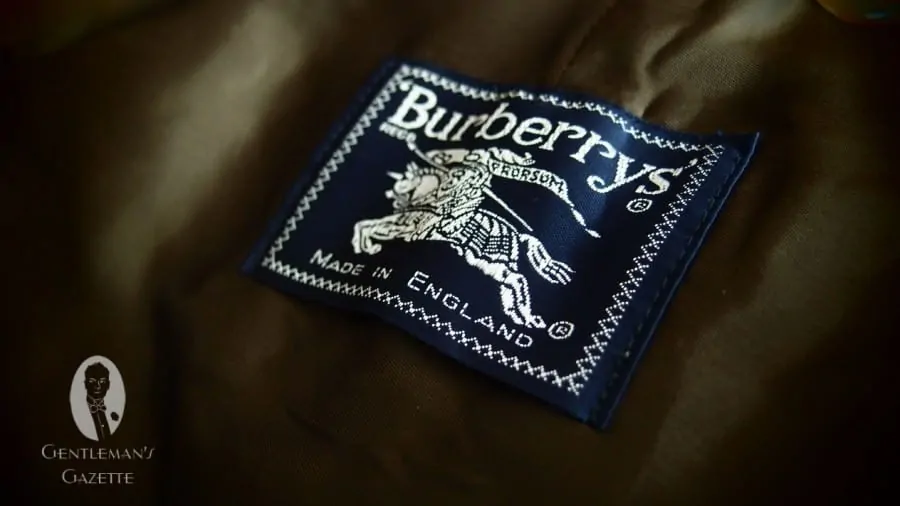
Other Burberry Labels
To complicate matters, the company has a number of other labels which are also used for Trench Coats:
BURBERRY BLACK LABEL and BURBERRY BLUE LABEL are made tailored for Japanese customers under license by Sanyo Shokai. While a few of them are made in Japan, the bulk of these trench coats are made in China. In our experience at the Gentleman’s Gazette, we don’t recommend these as quality trench coats.
BURBERRY PRORSUM is the high-end label of the company. It is generally more fashion-forward with a price tag to match. If you find one you like, go for it, though it has not much to do with the traditional British Trench Coat Burberrys’ was famous for.
Authentic or Fake Burberry Trench Coat?
Due to the popularity of the Trench Coat and the Burberry brand, you will occasionally find counterfeit Burberry trench coats. Fortunately, most fakes are of low quality and relatively easy to spot. These are the things you should pay attention to when searching for quality (pre-1999) Burberry Trench Coats:
Genuine Burberry Details
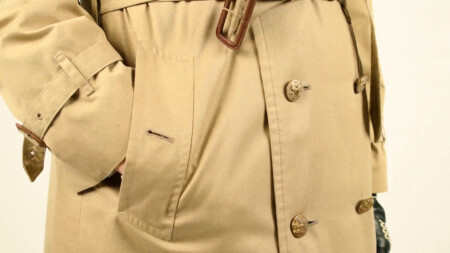
Neat Stitching
Genuine Burberry trench coats feature neat seams and stitching. For example, the belt loops are carefully reinforced with a little square stitch whereas fakes often feature sloppy stitching and little to no attention to detail.
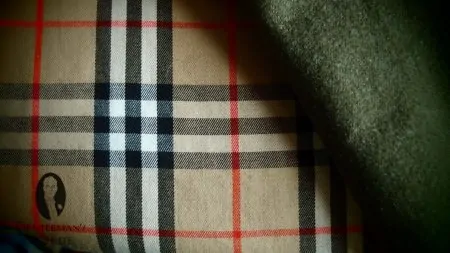
Matching Nova Check Pattern
On genuine Burberrys’ Trench coats, the Nova Check lining matches up neatly and it is always in the colors beige, white, black, and red. Different colors or mismatched checks are a hallmark of fakes.
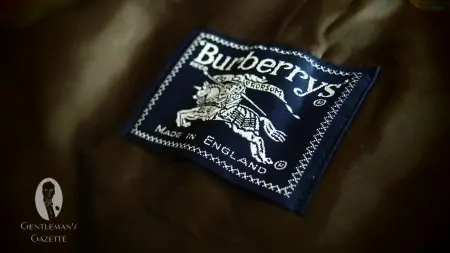
Correct Labels
Genuine pre-1999 trench coats have a white label in the left pocket with a Name and Order field. The size is always in the Name field. On the liner, the size label is hidden underneath the navy blue Burberrys’ label. If you cannot find these labels and they were not removed, it is a fake.
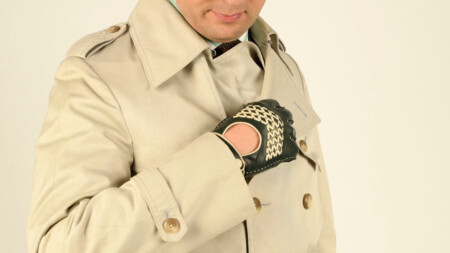
Quality Gabardine Fabric
The Burberry Gabardine is very hard-wearing and anything but flimsy. You can find it in 100% cotton, 51% Cotton 49% Polyester, and 67% Polyester 33% Cotton. Every other composition are not genuine.
Want to learn more about other overcoats?
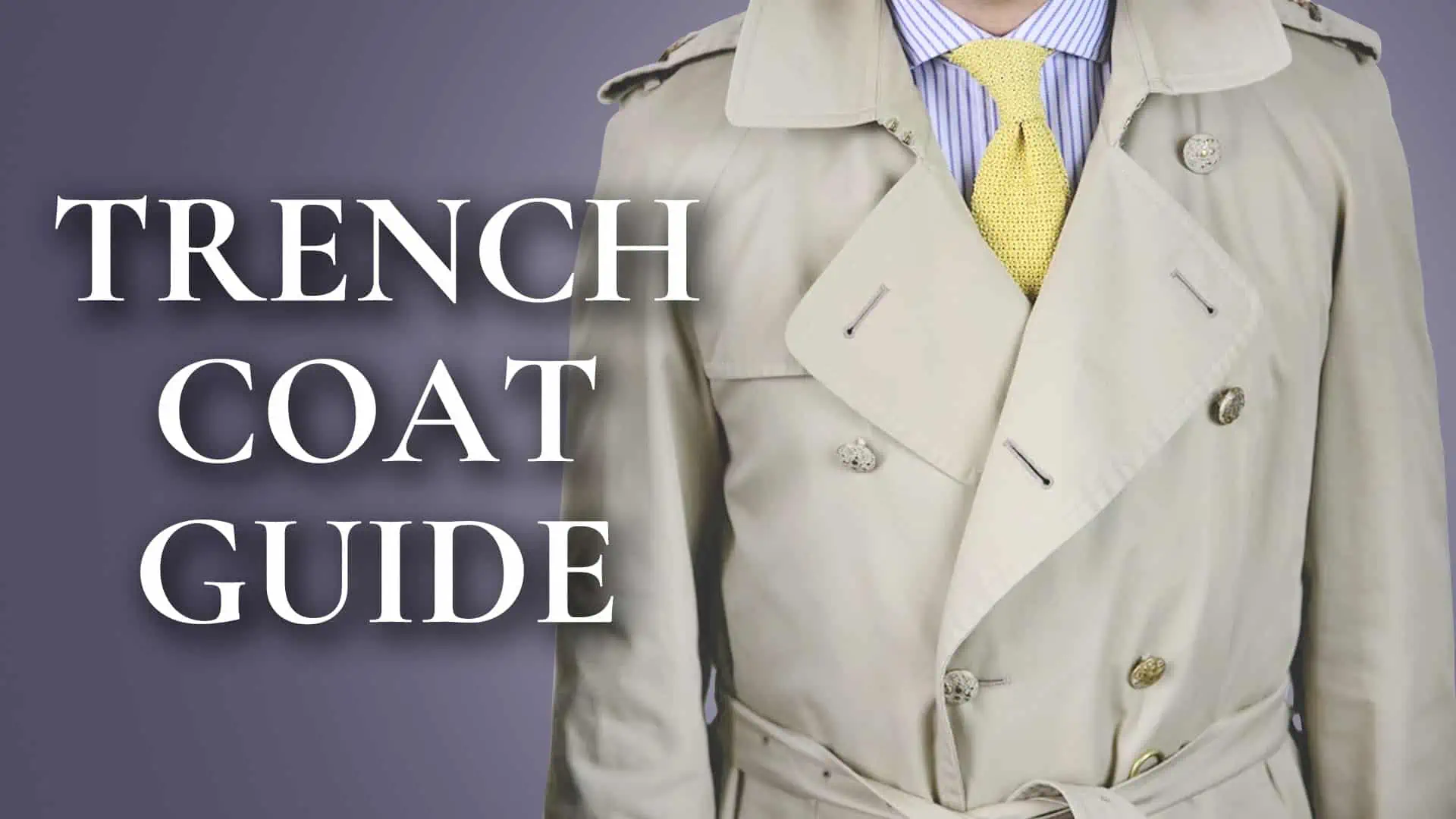
It is not Salvador Dali, it is Peter Sellers in Pink Panther.
Sorry, but that is a silly mistake : )
You are right. It stands corrected now.
Deliciously elaborate … well done and thank you
I think the soldier pictured in the 15th picture is Gary Cooper. Can someone confirm?
He definitely has a strong resemblance but I don’t think we ever fought as a soldier, so it could only be a movie. Any hints in that matter are appreciated.
My hunch this is from the movie ” Sergeant York ” a 1941 film directed by Howard Hawks starring Gary Cooper ( he in the photo ) for which he won an Oscar for best actor.
The photo of the soldier is probably Gary Cooper. It could be from his famous film, “Sergeant York.”
The trench coat has endured as a classic. In comparison, another military coat, the British warm, is rarely seen. It was once very popular and was available in classic clothiers. This is no longer the case, but all classic clothiers carry trench coats.
I have a couple of classic English trench coats as well as a few more “fashion forward” models which do not religiously follow all of the detailing and fabric choices. For example, I have a couple of Alan Flusser raincoats in a bamboo microfiber. These were made in Italy.
It is interesting that in view of the detailing and expensive materials (quality cotton exterior and interior and leather buckles), an authentic trench coat can be over $1,500.
Brooks Brothers and Paul Stuart offer excellent trench coats under their own label. I would say that Paul Stuart’s coat is excellent.
Thanks for your comment, Mark. We discussed the Gary Cooper question on Facebook and basically, two movies were suggested. I have not taken a look at the myself yet, so I cannot confirm
My navy color trench issued from the coast guard does plenty of double duty work in the civilian world.
Hello, could you please answer this question concerning where to buy a bespoke one?
http://b.qr.ae/W8v7t8
Excellent study – I am still reading through it. Bravo……..
Eventually you should collate all these wise words (on various garments) and bring them out as a book….. (I bags write the Foreword!).
What are other brands that’s worthy of mentioning?
murtadza
At least two men seem to be dead in the trench while others are stepping over their bodies… But sorry, we’re talking of Aquascutum and Burberry’s. We may appreciate those (too expensive) garments but I’m afraid the picture is quite inappropriate.
I don’t think the Bogie promo shot #13 is from Casablanca. This still from Casablanca shows a coat with set shoulders and two gun flaps – the Aquascutum Kingsway – while the shot of Bogart has raglan sleeves and only a right-hand gun flap.
http://thechicspy.com/wp-content/uploads/2012/03/Bogart-Bergman-Casablanca-1942.jpg
Charles, thank you for your comment! Could it be that he wore an Aquascutum and that he later switched to Burberry? I am pretty sure that the last picture is in fact from Casablance, see here
apart from the standard british trench coat houses, one can find excellent examples of the garment at the italian allegri and american – japanese sanyo
If you ever find yourself in London then the Burberry and Aquascutum outlets are great places to pick up a trench coat for significantly less than the regular price. I bought mine (admittedly in the sale) in for third of the price it should have been.
The two store are next to each other in the middle of a somewhat run down industrial in Hackney. Worth making the trip though.
Thanks for the hint Dan, can you share a specific address with us?
What about London Fog trench coats? They were made in America, I have not seen them lately. Thanks for the great article.
You can still find them on ebay occasionally. On their website they seem to offer some “trench coats” with double gun flap, so obviouly they are more fashion forward now.
Loved your article on trench coats. But as an owner of a vintage Burberry trench, I’m afraid you’re incorrect–they no longer make their traditional model . Everything today is higher style, and above-the-knee versions. I’m babying my real classic 100% cotton gabardine model, and hope it lasts a lifetime, because I’m afraid I’ll never be able to replace it.
Well, they always had plenty of different models with different cuts. Yes, they do not make the pre-1999 style ones, but I would still call them a trench coat. But as highlighted in the article, the pre-1999 is my favorite too.
Was the shop in Hamburg Rudolf Beaufays?
One of my favorites.
(Known to the local expat crowd as “Dead Englishmen”)
Yes it was!
The one problem that I have with Trench Coats is that I always seem to lose the belts.
I have a very hard time when trying to locate replacements (even when contacting makers) – colour matching seems to be a particular problem for me, and I do not like compromising on a belt that is not quite the same colour/shade as the original.
Do you have any suggestions?
Get one with D-Rings because that prevents the belt from coming out of the loops.
Great article.
At Burberrys HQ store in London you can have a trench coat made up to your own design using their old patterns, so you can add or subtract D rings, gun flaps etc or just choose an original WWI design.
With anniversaries of WWI battles and the Anglo-Irish War (where they were popular with Guerillas operating as Flying Columns, many being WWI veterans as well as Auxilaries and Black & Tans) and 1916 Rising commemorations coming up no doubt the trench will remain a hot product in style terms.
I am glad to hear they still do that! I wonder how many different patterns they offer and if they can supply the old fabric qualities etc.
Excellent information thanks so very much!
Absolutely an incredible amount of information — and great photographs — in this article!
Well done!
Dear Sven – got my pre-1999 Burberrys at an (Anglican) Church of England thrift shop for $1 (Cdn)! I highly recommend Anglican thrift shops in Canada and the USA, plus the Oxfam shops in the Home Counties (UK). Thank you for a most excellent and informative article, I really learned a lot for future “expeditions.”
I tried to leave a comment on the Burberry trenches earlier, but it seems to have gotten lost. My apologies if this ends up being a duplicate. Looking at Burberry’s web site, I see the Heritage collection prominently displayed and in that collection is the Westminster, a long, traditional trench. Here is the description they provide:
…”classic fit trench coat, The Westminster is tailored to the body with a generous cut.
The coat is made in England from weatherproof cotton gabardine, invented by Thomas Burberry in 1879.”
https://us.burberry.com/the-westminster-long-heritage-trench-coat-p39066901
Now, I don’t know the older ones so I’ll defer to you folks who own them and know them well, but this description seems to contradict the comments above that say everything is high style, above the knee, not made of cotton gabardine, etc.
I’d love to own a previously enjoyed, well cared for classic Burberry for a song, but as with all such things, getting my larger size, a genuine article, in a color I want, with no rotting leather buckle covers, etc… all seems rather dicey. And while I’ve done some good business on eBay, it’s a treacherous place sometimes. I wanted a Beck Diplomat shoe polisher and I wanted to be sure it would be something I would actually use and enjoy before I spent nearly $300 on a new one. eBay supplied a reasonable one for $60 and while it isn’t perfect, I now know how awesome they are and if I want perfection, I will gladly pay full retail. I don’t have to do that with a Burberry trench as there is a Burberry retail store nearby for me to try them on with my suit on, etc., as this article suggests. I like getting a deal but if I’m wearing it in public, it needs to be up to my standards. I think the Westminster in Navy would be my choice.
Thanks for sharing Joe, this is indeed a made in England coat. The old ones did not have the undercollar check and $1895 is steep for cotton gabardine but hey, it is an attractive cut for sure.
That being said, it’s not difficult to find big sizes because they were often cut large…
ps: when you post links, comments are held for moderation because we get about 3,000 spam comments a day and so we need to filter by certain criteria.
Mate,
Thank you so much for the article! Armed with this information, I went hunting for a trench coat and you cannot imagine my delight when I found a Burberrys not only in my size but also in near mint condition for just over $200 at the very first op shop I visited! The label says “Made in England for Harrods”, but Google tells me that’s fine :-)
Dennis, I am glad to hear that. Well done!
I would get rid of the emblems on the epaulettes. I don’t think anyone would believe that you were in the British Army, and it’s a bit like wearing the regalia of a college that you didn’t attend. Even as a former soldier, I would probably keep any references to my old regiment down to switching the buttons. I think you rather lessen the authenticity when you add emblems to a piece of clothing that don’t really have anything to do with you.
Each to his own.
A lot of nonsense in this “article” regarding German trench coats in WW2. We shouldn’t wear black leather trench coats? Absurd, the roads are clogged with Mercedes Benz autos. One can’t see it in black and white photos, but German army officers wore field green leather trench coats, air force was light grey, Nazi party officials wore brown, SS officers wore black.
Dear Sven- further to my remarks of 30 October…on 12 November specifically went hunting for a new (ie, used) trenchcoat at a large 2nd hand store here in Canada and found an Yves St Laurent for $8.99 Cdn! The only thing lacking is the belt. Now to find one with D rings and matching khaki colour……. and thank you again for your most informative article. Looking fwd to reading more of your posts.
Hi there,
I came across your great article while doing some research about the vintage burberry’s trench I found at a garage sale.
Mine fits all the details of your pre-1999 above, however not only does it have a navy blue Burberry’s label, it also has an Austin reed label seen just under it.
I can’t find anything about Burberry’s making coats for Austin Reed. Do you have any thoughts on this? Thanks!
Well, it is not unlikely that they worked for Austin Reed.
May I ask why one should steer clear of Chinese made coats? Where is your iPhone made? Do you own any Chinese made Burberry products? If so, was the quality so bad that it made you feel the need to warn others about products from my country?
Little tired of and offended by hearing of the awful quality of Chinese made products, as QC has improved greatly in the last decade.
Jack, I do neither use an iphone nor a made in China Burberry trench coat. I just visited China for several weeks and the level of quality I encountered often leaves a lot to be desired. Yes, I felt the need to warn our readers because they do not stack up at the moment.
If you read our articles, you will see that we strongly believe that you can find quality anywhere. That being said, most ready made clothing and things like ties and pocket squares are still way off from European standards.
However, that may change in the future. 100 years ago, Made in Germany was perceived in a similar way as Made in China is now, but Made in Germany today is often perceived as excellence. Who knows maybe a few years down the road China will have better products. Today, you find more bad Chinese products than good ones in my experience.
Perhaps that is true of many cheaply made Chinese products, of which similar quality I’m sure you can find manufactured in any country–however we are not talking about the quality of clothing in general. You warned your readers about Chinese made Burberry Black/Blue label products; so I ask you about your experience specifically with Chinese made Burberry Black/Blue label products. If, as you now claim, you have no experience with Chinese made Burberry Black/Blue products, I would expect you to retract your statement. As you have admitted yourself, quality can be found anywhere, much like my example of Chinese made iPhones (and I’m sure there are many other examples).
When it comes to quality, really the most important thing is experience and QC. Apple is able to produce such a polished product in China because of tight QC. You assume Burberry is not able to do the same with their suppliers?
Jack,
I suggest you read what I write before claiming I said something I did not.
I never said I had no experience with Chinese Burberry Trenchcoat, I said I do not use them, that is a huge difference.
I have been to China and I have seen China-made Trench coats in person, I tried them on and inspected them closely and I do not want them because the workamnship, the fabric and the cut were not flattering in any way.
Of course, you are welcome to write your own article about Chinese trench coats on your own website, but at this point the quality of Chinese Burberry Trenchcoats is not worth being recommended, in my opinion. Maybe that will change in the future.
Can anyone tell me more about through pockets of a Trench Coat, because I can’t find anything on that, I would like to make some alterations on my coat and I really like through pockets.
I have a pre 1999 Burberrys’ trench. I knew the name had changed but had no idea that I had “the real thing” verses the later models. Good to know.